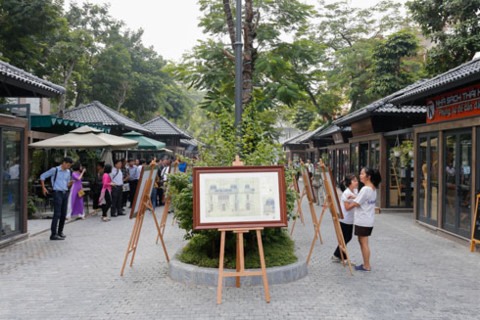 Life & Style
Life & Style

Over nearly a century of rule in Việt Nam, the French aimed to build a “French-style administrative capital in Indochina”. That legacy today is visible in many edifices that feature Western-style architecture and combinations of Vietnamese and Western attributes.
 |
| The exhibit includes over 30 administrative documents, images and technical drawings on typical French architectural constructions being stored at National Storage Centre I. — Photo anninhthudo.vn |
HÀ NỘI — Over nearly a century of rule in Việt Nam, the French aimed to build a “French-style administrative capital in Indochina”. That legacy today is visible in many edifices that feature Western-style architecture and combinations of Vietnamese and Western attributes.
Now, an exhibit of archives and documents, entitled French Architecture in the Heart of Hà Nội, will allow visitors to better understand the history of the buildings that contribute to the city’s unique character. The exhibit opened at Hà Nội Book Street (19/12 Road, Hoàn Kiếm District), last Friday.
The exhibit includes over 30 administrative documents, images and technical drawings on typical French architectural constructions being stored at National Storage Centre I.
The show was co-organised by the State Records Management and Archives Department of Việt Nam under the Ministry of Home Affairs and the Hanoi Opera House.
At present, documents relating to construction during French colonial rule are stored at National Storage Centre I of the State Records Management and Archives Department of Việt Nam. The documents include administrative records, records of state offices’ design and execution, manors, hospitals, museums, libraries, schools and residencies for high-ranking officials of French ruling government.
Constructions built by French architects in Hà Nội remain one of the remarkable architectural highlights of the capital. These legacies of high aesthetic characteristics, combined with recent construction shaping a new face for Hà Nội, make the city look both vintage and modern.
Some of the most famous buildings designed by French architects in the end of 19th century and the beginning of 20th century include the Hà Nội Opera House, Louis Fino Museum (now renamed Việt Nam National Museum of History), Hà Nội International Post Office, Hà Nội University of Science, Ministry of Foreign Affairs headquarters and Doumer Bridge (now Long Biên Bridge).
Trương Văn Thọ, who lives near the Opera House and visited the exhibition, said the documents are valuable items for the capital public to learn more about Hà Nội’s past.
“After the French left, they have given these timeless and priceless legacies to the capital, not only for the older generation but for young people to look up to,” he said.
Vũ Văn Đại, an architect from Nam Định, said he comes to the exhibition to learn more about the inspiring documents.
“Among these construction sketches, I’m impressed most with the Hà Nội Opera House. I love music and so often am inspired by this amazing construction,” he said. “French architects usually build a high foundation to most of the buildings, and they are seven stories or shorter. The buildings also survive the humid weather in our country, thanks to French idea of elevating the basement higher to reduce the effects of humidity and high temperatures, so you feel cool when standing inside them.”
The organising board hopes the exhibition will help the public gain a fuller vision of the legacy of the colonial era on the capital’s architecture, and promote interest in work to preserve that legacy.
The exhibition opens free to public and lasts until November 5. — VNS




